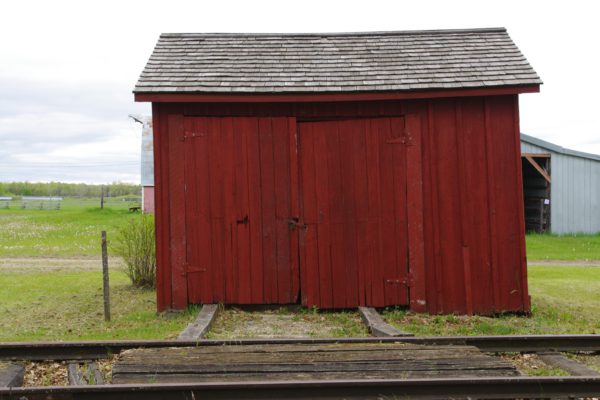
This very simple little building served as a tool storage shed for the section crew which maintained the Canadian Pacific Railway (CPR) mainline around Austin. The shed was located in Austin.
This building has a number of features which point to an early construction date. This building features board and batten siding. Board and batten siding consists of boards nailed on vertically and flat against the buildings framework. The joints between the boards are then covered with a narrower board, the batten, which is nailed over the joint. Board and batten construction was very common in Pioneer Canada before 1900. One advantage of board and batten was that it could make use of varying widths of boards and the edges did not have to be perfect as the battens were 2-4 inches wide. Board and batten construction on the railways seemed to have fallen out of use by the 1890s.
As well, the tool shed features rough sawn 2 x 4 framing, that is the 2 x 4s were not planed and so are the full 2 x 4 dimension. Rough sawn materials were also commonly encountered in Pioneer Canada construction and began to become uncommon after 1920 as the technology of lumber planers improved and the advantages of planed lumber became apparent.
Given the construction which points to a construction date before 1900, it is quite likely this tool shed was the only tool shed ever constructed at Austin. While the CPR track was completed coast to coast in Canada by 1885, it took at least another 10 years to bring the CPR up to full operational standard with the provision of railway buildings and facilities plus ballasting of track and filling in of trestles with earth where practical.
By 1995, track maintenance had changed significantly with maintenance forces being provided with trucks to move around with. The tool shed at Austin was no longer needed and so was offered to the Museum.
It is interesting to note that a CPR diagram exists inside the tool shed that lists the tools that should be in the shed and stipulates where they are to be stored. This indicates standardization of tool sheds and their contents. Probably this was done so that almost any CPR employee could enter the tool shed and quickly locate the tool needed or just as quickly determine it was not in the shed. Of course, this assumes the section gang followed the diagram.
Section gangs were a fixture on rail lines up to the 1970s. Lines were divided up into sections and assigned to specific gangs. Each gang maintained the track, replacing ties and damaged rails, maintaining road crossings, signage along the track and other tasks in their section. Often the section crew lived in a bunk house located alongside the track. The foreman usually lived in a house owned by the railway which was also located along side the track, the so called section house. Steam locomotives, for various reasons, were hard on track which resulted in a need for ongoing maintenance. Diesel locomotives were easier on track resulting in less maintenance. As well, track maintenance became increasingly mechanized through the 1960s. Section gangs began to disappear in the 1970s and were replaced by crews that cover much greater sections of track. As well travelling crews with specialized machinery travel the country doing such jobs as replacing the rail or ties in sections of track.
Section gangs offered local employment opportunities to farmers and their sons. As well remaining on good terms with the local section gang was advisable as the gang was equipped with heavy jacks, chains, cables, timbers and other items which farmers of the time had the occasional use for. If the farmer could borrow the item from the gang, he could avoid purchasing the thing or going further afield to borrow one.


